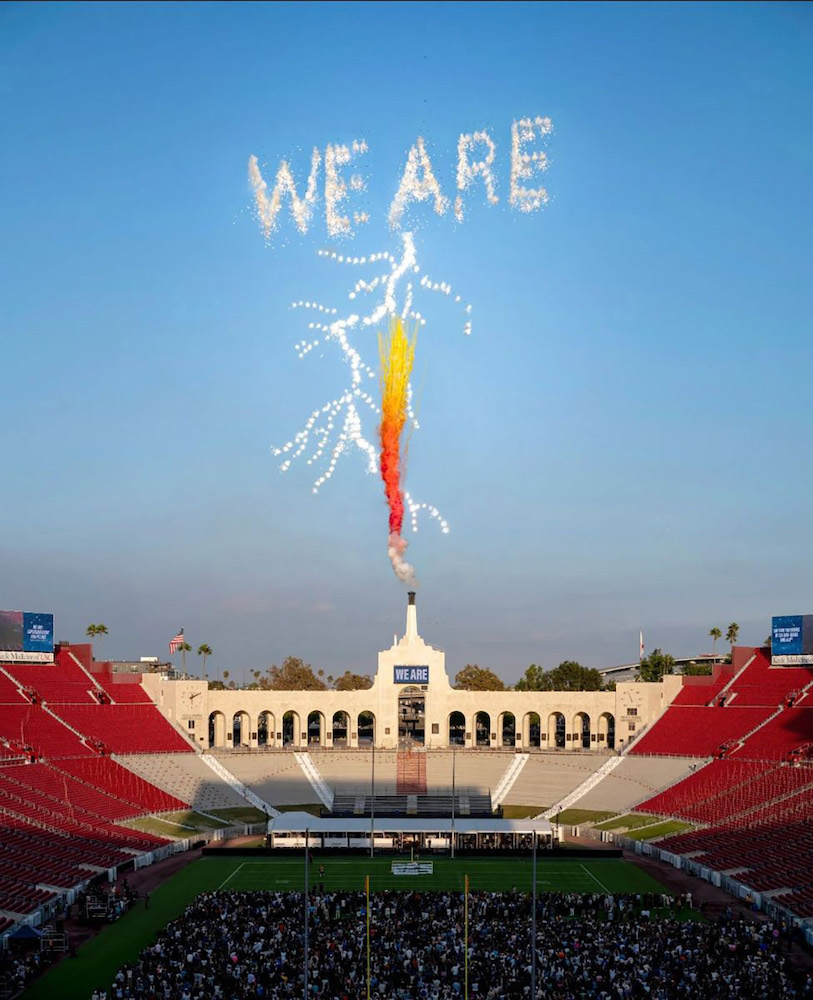At dusk on September fifteenth, nearly 5,000 spectators gathered on the field of the Los Angeles Coliseum to view WE ARE: EXPLOSION EVENT FOR PST ART, a monumental daytime fireworks display by Cai Guo-Qiang* and his custom artificial intelligence model cAI™. Commissioned and presented by Getty in collaboration with the University of Southern California, the half-hour opening event to “PST ART 2024: Art & Science Collide” celebrated a blue-chip artist planting his flag in generative AI.
Calling cAI™ a vanity project may be too on the nose. The AI model bears the artist’s name and is trademarked and branded with its own logo, which appeared in the sky in a constellation of drones equipped with pyrotechnic devices. Trained on Cai’s archive, cAI™ applies deep learning to reflect the artist’s interests and biases. Employing the AI model as a mouthpiece, Cai narrated the event in Chinese, his project manager translated his words into English, and cAI™ spoke her translation, its voice simulating Cai’s timbre and accent. The accompanying fireworks, which exploded in the stands and the airspace above the stadium, and the content simultaneously presented on the stadium’s mirrored display screens were cAI™’s response to the artist’s question “What is the fate of humanity with AI?”
Structured in five acts, cAI™’s forecasts resembled those of a Magic 8 Ball. In one sequence of explosions, the AI model proposed a mathematical formula followed by a lengthy explanation that leaned heavily on mystical abstraction. In another, cAI™ offered a series of portmanteaux it had coined—echoanta, synthview, altcog, logicloom and humavisor—spelling the words out in the stands in monochromatic puffs of smoke.
cAI™’s allusions, which Cai often called out in his narration, further muddled its answer. The name of ACT I DIMENSIONALITY REDUCTION refers to a common method for enhancing machine learning models. In ACT II WE ARE, a snaking line of explosions traveled rapidly through the stands, a nod to the serpent in the Garden of Eden. ACT III THEFT OF FIRE featured a lightning-bolt formation followed by an eruption of skyward bursts of red and orange pigments, referencing the ancient Greek myth of Prometheus, who stole lightning from Zeus to give man fire. In ACT IV BIRD OF PARADISE, colorful bouquets of smoke that were launched along the perimeter of the stadium formed a ring in the sky, representing the floral emblem of Los Angeles. ACT V DIVINE WRATH pointed to Zeus’s retribution against Prometheus and God’s punishment of Adam and Eve, or so I gather.
In the final act, we found ourselves directly in the fallout zone as shell fireworks launched overhead in a dense and roaring barrage of explosions. Surrounded by a tumult—sharp cracks and thundering booms that surpassed the threshold of discomfort, sparks flying above, plumes blossoming and dissipating around us, cardboard and clay debris falling from the sky—spectators covered their ears, noses, mouths, heads, and eyes with nowhere to seek cover. Given his mastery of fireworks, Cai would have been certain of this outcome.
The finale was a breach of trust, its aggression revealing the limits of intelligence and an extraordinary loosening of permission structures. Under Cai’s direction, cAI™’s inherent combination of knowing without feeling is dangerous. Under the auspices of Getty, USC, and PST ART, Cai is too.
*Cai pronounced like the word sigh with a t in front of it, Guo like gwuh, Qiang like cheeahng, the sound of its last three letters bearing a closer resemblance to the -ong in Cheech & Chong than the ang- in angle.


